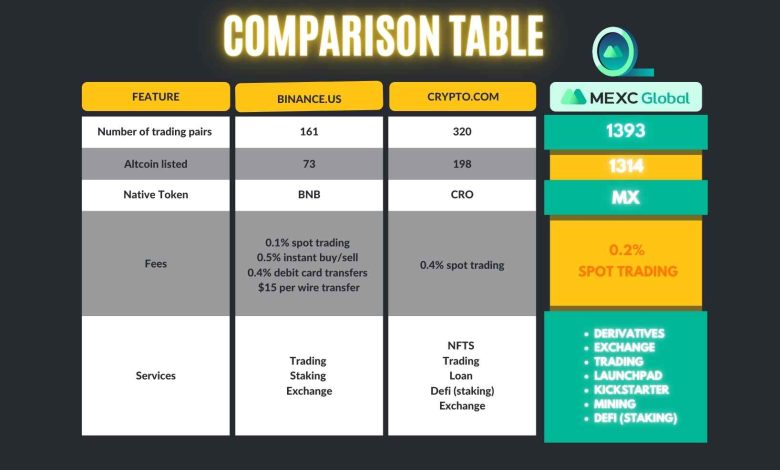Comparing Fees on Major Crypto Exchanges

- Understanding the fee structures of major crypto exchanges
- Analyzing the costs of trading on popular cryptocurrency platforms
- Comparing fees for buying and selling digital assets on leading exchanges
- Exploring the hidden charges of top crypto trading platforms
- Tips for minimizing fees when trading cryptocurrencies on major exchanges
- A comprehensive guide to fee comparison on the biggest crypto exchanges
Understanding the fee structures of major crypto exchanges
Understanding the fee structures of major cryptocurrency exchanges is crucial for traders looking to optimize their trading costs. Each exchange has its own fee schedule, which can vary based on factors such as trading volume, type of trade, and payment method. By comparing the fee structures of different exchanges, traders can choose the platform that offers the most cost-effective trading experience.
Some exchanges charge a flat fee per trade, while others use a percentage-based fee. Additionally, some exchanges offer discounts on fees for high-volume traders or users who hold a certain amount of the exchange’s native token. It is important to consider these factors when evaluating the overall cost of trading on a particular exchange.
When comparing fee structures, traders should also take into account deposit and withdrawal fees. These fees can vary widely between exchanges and can significantly impact the overall cost of trading. Some exchanges offer free deposits but charge a fee for withdrawals, while others may charge fees for both. Traders should carefully review these fees before choosing an exchange.
Analyzing the costs of trading on popular cryptocurrency platforms
When it comes to trading cryptocurrencies, one of the key factors to consider is the fees charged by popular platforms. Analyzing the costs of trading on different exchanges can help investors make informed decisions and maximize their profits. Let’s take a closer look at the fees charged by some of the major cryptocurrency exchanges:
- Binance: Binance is known for its competitive fees, with a standard trading fee of 0.1% per trade. However, users can get a discount on trading fees by using Binance Coin (BNB) to pay for transactions.
- Coinbase: Coinbase is popular among beginners due to its user-friendly interface, but it charges higher fees compared to other exchanges. The platform charges a spread of about 0.5% for buying and selling cryptocurrencies.
- Kraken: Kraken offers a tiered fee structure based on trading volume, with fees ranging from 0.16% to 0.26% per trade. The platform is known for its security features and wide range of supported cryptocurrencies.
- Bitfinex: Bitfinex charges a maker-taker fee model, with makers paying 0.1% and takers paying 0.2% per trade. The platform also offers discounts based on trading volume.
It’s important to consider not only the trading fees but also other costs such as deposit and withdrawal fees, as these can impact your overall profitability. By comparing the fees of different cryptocurrency exchanges, investors can choose the platform that best suits their trading needs and budget.
Comparing fees for buying and selling digital assets on leading exchanges
When it comes to buying and selling digital assets on major cryptocurrency exchanges, one of the key factors to consider is the fees involved. These fees can vary significantly between exchanges, impacting the overall cost of trading. To help you make an informed decision, we have compared the fees for buying and selling digital assets on some of the leading exchanges in the market.
**Binance**: Binance is known for its competitive fee structure, with fees starting at 0.1% for both makers and takers. However, users can enjoy lower fees by holding Binance Coin (BNB) and using it to pay for trading fees.
**Coinbase Pro**: Coinbase Pro charges a maker fee of 0.5% and a taker fee of 0.5%. While these fees are higher compared to some other exchanges, Coinbase Pro is known for its user-friendly interface and high liquidity.
**Kraken**: Kraken offers a tiered fee structure based on trading volume, with fees starting at 0.16% for makers and 0.26% for takers. The fees can go as low as 0% for makers and 0.10% for takers for high-volume traders.
**Bitfinex**: Bitfinex charges a maker fee of 0.1% and a taker fee of 0.2%. The exchange also offers discounts for high-volume traders, with fees going as low as 0% for makers and 0.055% for takers.
**Gemini**: Gemini has a maker fee of 0.25% and a taker fee of 0.35%. While these fees are slightly higher compared to some other exchanges, Gemini is known for its strong security measures and regulatory compliance.
Overall, when comparing fees for buying and selling digital assets on leading exchanges, it is essential to consider not only the fee structure but also factors such as security, liquidity, and user experience. By choosing an exchange that aligns with your trading needs and preferences, you can optimize your trading experience and minimize costs in the long run.
Exploring the hidden charges of top crypto trading platforms
When it comes to trading cryptocurrencies, it is essential to consider the fees charged by different platforms. While some exchanges may advertise low trading fees, there are often hidden charges that can significantly impact your overall profits. It is crucial to explore these hidden fees to make an informed decision about which platform to use for your crypto trading.
One common hidden charge on top crypto trading platforms is the withdrawal fee. While some exchanges offer free withdrawals for certain cryptocurrencies, others may charge a flat fee or a percentage of the withdrawal amount. These fees can quickly add up, especially if you are making frequent withdrawals from your trading account.
Another hidden charge to watch out for is the deposit fee. Some exchanges may charge a fee for depositing funds into your trading account, which can eat into your initial investment. It is essential to consider these fees when choosing a platform, as they can vary significantly between exchanges.
In addition to withdrawal and deposit fees, many crypto exchanges also charge a spread on trades. The spread is the difference between the buying and selling prices of a cryptocurrency, and it represents the exchange’s profit. While some platforms offer tight spreads, others may have wider spreads that can impact your trading profits.
Overall, it is crucial to carefully examine the fee structure of different crypto trading platforms before making a decision. By exploring the hidden charges and comparing fees across exchanges, you can choose a platform that aligns with your trading strategy and helps you maximize your profits in the volatile world of cryptocurrency trading.
Tips for minimizing fees when trading cryptocurrencies on major exchanges
When trading cryptocurrencies on major exchanges, it is important to be mindful of the fees involved to maximize your profits. Here are some tips to help you minimize fees:
- Consider using limit orders instead of market orders, as they often come with lower fees.
- Look for exchanges that offer discounted fees for high-volume traders, as this can help reduce your overall costs.
- Keep an eye out for promotions or fee discounts offered by exchanges, as these can provide temporary relief from high fees.
- Consider consolidating your trades to reduce the number of transactions you make, as this can help lower your fees in the long run.
- Regularly review and compare fee structures across different exchanges to ensure you are getting the best deal possible.
By following these tips, you can minimize the fees you pay when trading cryptocurrencies on major exchanges, allowing you to keep more of your profits for yourself.
A comprehensive guide to fee comparison on the biggest crypto exchanges
When comparing fees on major crypto exchanges, it is essential to conduct a comprehensive analysis to ensure you are getting the best value for your trades. Different exchanges have varying fee structures that can significantly impact your overall profitability. By understanding the fee comparison on the biggest crypto exchanges, you can make informed decisions on where to execute your trades.
One of the key factors to consider when comparing fees is the type of fee structure employed by each exchange. Some exchanges charge a flat fee per trade, while others use a percentage-based fee. Additionally, some exchanges offer discounts on fees for high-volume traders or users who hold a certain amount of their native token.
It is also important to consider the deposit and withdrawal fees on each exchange. These fees can vary widely and may eat into your profits if you are not careful. Some exchanges offer free deposits but charge a fee for withdrawals, while others have fees for both. By factoring in these fees, you can better understand the true cost of trading on each platform.
Another crucial aspect to consider is the maker and taker fees on each exchange. Maker fees are charged when you add liquidity to the order book by placing a limit order that is not immediately filled, while taker fees are charged when you remove liquidity by placing a market order that is immediately filled. Understanding these fees can help you optimize your trading strategy and minimize costs.
By conducting a thorough fee comparison on the biggest crypto exchanges, you can ensure that you are getting the best value for your trades. Consider all aspects of the fee structure, including trading fees, deposit and withdrawal fees, and maker and taker fees, to make an informed decision on where to execute your trades. Remember that fees can have a significant impact on your overall profitability, so it is essential to choose an exchange with fees that align with your trading strategy.



